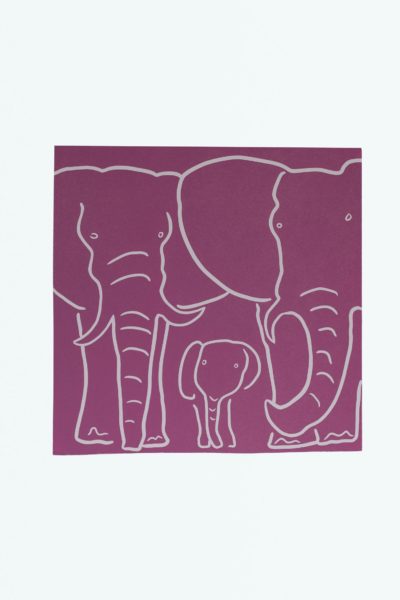Andy Warhol | Flowers – Hand Coloured (F&S II.118) 1974
DETAILS
Andy Warhol | Flowers – Hand Coloured (F&S II.118) 1974
Screenprint, hand coloured with Dr. Martin’s aniline watercolour dyes on Arches paper
41 x 27¼ in. | 104 x 69.5 cm
Signed and numbered by the artist
Edition of 250
Andy Warhol | Flowers – Hand Coloured (F&S II.118) 1974
Unique screenprint in black and white, hand-coloured with Dr. Martin’s aniline watercolour dyes on Arches paper and J. Green paper, initialled in pencil by the artist, also signed by the artist in pencil, dated ’74 and numbered on the reverse from the edition of 250 (there were also 50 artist’s proofs), printed by Alexander Heinrici, New York, co-published by Peter M. Brant, Castelli Graphics, and Mutiples, Inc., New York, with their inkstamp on the reverse, 104 x 69.5 cm. (41 x 27¼ in.)
The ‘Flowers (Hand-Coloured)’ series closely followed the earlier series ‘Flowers (Black and White)’ with one significant difference, the exquisite hand-colouring Warhol applied to these screenprints making each unique. Made in 1974, this series is a sudden diversion away from his typical artistic style of the time since the artist’s hand is very much felt with the addition of this hand-colouring – Warhol usually delighted in removing all trace of his presence from his work.
Through this series we are reminded of what a talented draftsman Warhol was whilst first working as a commercial artist in the 1950s. The freehand lines Warhol uses to capture these still-life flowers and the bursts of vibrant colour are also reminiscent of his earlier offset lithographs from the 1950s like ‘A La Recherche Du Shoe Perdu’ and ‘Wild Raspberries’.
Andy Warhol
Andy Warhol (1928 – 1987), artist, printmaker, film maker, director, the producer was a leading light in the pop are a movement. Born on 6th August 1928, in Pittsburgh, Pennsylvania, Warhol studied commercial art at the Carnegie Institute of Technology (now Carnegie Mellon University), where he joined the Beaux-Arts Society and took on the role of Art Director of the student magazine Cano. He earned a Bachelor of Fine Arts in pictorial design in 1949, and later that year began his career in magazine illustration in New York City.
Warhol began exhibiting his work during the 1950s. He held several exhibitions at the Hugo Gallery and the Bodley Gallery in New York, and the Ferus Gallery in Los Angeles (the debut of his famous Cambell’s Soup Cans). His first solo exhibition was held at Stable Gallery in New York in 1962. The same year, New York’s Museum of Modern Art (MoMA) hosted a Symposium on Pop Art featuring Warhol’s work.
Warhol founded his own studio “The Factory” in the early 1960s, and a wide range of artists, writers, celebrities and musicians collaborated or exhibited there. Warhol was included in many exhibitions alongside contemporary pop artists; particularly seminal to his career was the 1964 exhibit The American Supermarket held in Paul Bianchini’s gallery in New York. The show – designed like the average American supermarket – confronted Warhol’s viewers with questions of consumerism, the perennial nature of what art is – or should be – and the links between market culture and artistic representation or documentation. The 1960s served as a backdrop to Warhol’s filmography; he made more than 60 films between 1963 – 1968 and continued to produce and paint, all the while challenging viewers to reconceive their notion of art and embrace the necessity of popular culture’s presence within institutions such as galleries, museums and art fairs.
Warhol began to work to commission in the 1970s, painting celebrity portraits which would later be exhibited in the Jewish Museum in Manhattan in 1980. In the wake of an attempt on his life in 1968, Warhol increased greater security at The Factory and devoted more time to securing wealthy patrons he could paint for commission. His subjects included Shah of Iran Mohammad Reza Pahlavi, the Shah’s sister Princess Ashraf Pahlavi, Mick Jagger, Prince and Diana Ross. Warhol founded Interview Magazine in 1975, using the medium to publish his views on philosophy, art and the blurred lines between creativity and business. In 1979, Warhol founded the New York Academy of Art.
Warhol’s death in 1987 saw him leave his entire estate to a foundation dedicated to the visual arts, named The Andy Warhol Foundation for the Visual Arts. Warhol’s collectors are worldwide, with a large repository of his work on display at The Andy Warhol Museum in Pittsburgh.
Andy Warhol Collection
We accept payment with Credit/Debit card, Paypal
If you’d like to buy an artwork priced at £5,000 or more, we ask you to get in touch with us to confirm the purchase. This is because high value artworks often require more specialist packaging and a bespoke shipping quote. As with all The Whisper Gallery purchases, we make the buying process as simple and hassle-free as possible and guarantee a first-class customer service.
MEASUREMENTS
DELIVERY & SHIPPING
All pieces are entirely handcrafted and unique. Please allow around 5-10 working days from placing the order for delivery.
For more information on our delivery, click here.
Read more about our exchange and returns policy here.
If you have any further questions, or if you need a delivery more urgently, please contact us.






